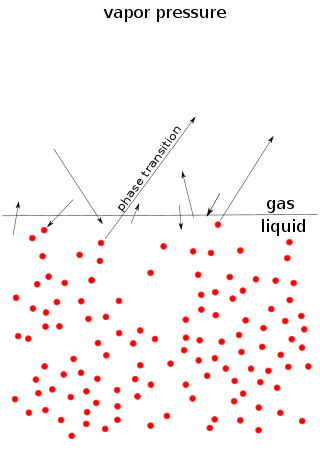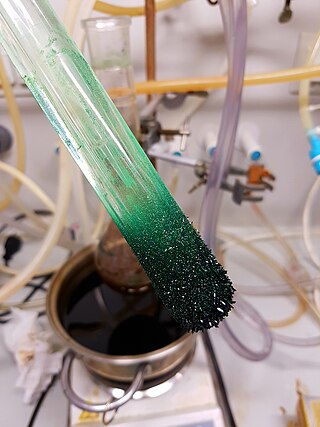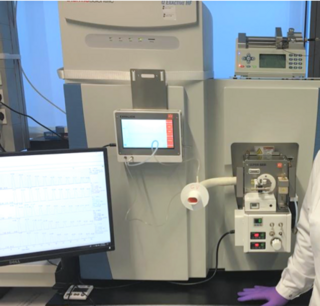Related Research Articles

The Miller–Urey experiment (or Miller experiment) was a chemistry experiment carried out in 1952 that simulated the conditions thought at the time to be present in the atmosphere of the early, prebiotic Earth, in order to test the hypothesis of the chemical origin of life under those conditions. The experiment used water (H2O), methane (CH4), ammonia (NH3), hydrogen (H2), and an electric arc (the latter simulating hypothesized lightning). CH4, NH3, H2 were taken in the ratio 2:2:1.

In physics, a vapor or vapour is a substance in the gas phase at a temperature lower than its critical temperature, which means that the vapor can be condensed to a liquid by increasing the pressure on it without reducing the temperature of the vapor. A vapor is different from an aerosol. An aerosol is a suspension of tiny particles of liquid, solid, or both within a gas.

Vapor pressure or equilibrium vapor pressure is the pressure exerted by a vapor in thermodynamic equilibrium with its condensed phases at a given temperature in a closed system. The equilibrium vapor pressure is an indication of a liquid's thermodynamic tendency to evaporate. It relates to the balance of particles escaping from the liquid in equilibrium with those in a coexisting vapor phase. A substance with a high vapor pressure at normal temperatures is often referred to as volatile. The pressure exhibited by vapor present above a liquid surface is known as vapor pressure. As the temperature of a liquid increases, the attractive interactions between liquid molecules become less significant in comparison to the entropy of those molecules in the gas phase, increasing the vapor pressure. Thus, liquids with strong intermolecular interactions are likely to have smaller vapor pressures, with the reverse true for weaker interactions.
Isoprene, or 2-methyl-1,3-butadiene, is a common volatile organic compound with the formula CH2=C(CH3)−CH=CH2. In its pure form it is a colorless volatile liquid. It is produced by many plants and animals (including humans) and its polymers are the main component of natural rubber. C. G. Williams named the compound in 1860 after obtaining it from the pyrolysis of natural rubber; he correctly deduced the empirical formula C5H8.

An ion source is a device that creates atomic and molecular ions. Ion sources are used to form ions for mass spectrometers, optical emission spectrometers, particle accelerators, ion implanters and ion engines.

Sublimation is the transition of a substance directly from the solid to the gas state, without passing through the liquid state. Sublimation is an endothermic process that occurs at temperatures and pressures below a substance's triple point in its phase diagram, which corresponds to the lowest pressure at which the substance can exist as a liquid. The reverse process of sublimation is deposition or desublimation, in which a substance passes directly from a gas to a solid phase. Sublimation has also been used as a generic term to describe a solid-to-gas transition (sublimation) followed by a gas-to-solid transition (deposition). While vaporization from liquid to gas occurs as evaporation from the surface if it occurs below the boiling point of the liquid, and as boiling with formation of bubbles in the interior of the liquid if it occurs at the boiling point, there is no such distinction for the solid-to-gas transition which always occurs as sublimation from the surface.
Volatile organic compounds (VOCs) are organic compounds that have a high vapor pressure at room temperature. High vapor pressure correlates with a low boiling point, which relates to the number of the sample's molecules in the surrounding air, a trait known as volatility.

Sulfur monoxide is an inorganic compound with formula SO. It is only found as a dilute gas phase. When concentrated or condensed, it converts to S2O2 (disulfur dioxide). It has been detected in space but is rarely encountered intact otherwise.

Endohedral fullerenes, also called endofullerenes, are fullerenes that have additional atoms, ions, or clusters enclosed within their inner spheres. The first lanthanum C60 complex called La@C60 was synthesized in 1985. The @ (at sign) in the name reflects the notion of a small molecule trapped inside a shell. Two types of endohedral complexes exist: endohedral metallofullerenes and non-metal doped fullerenes.
In atmospheric chemistry, NOx is shorthand for nitric oxide and nitrogen dioxide, the nitrogen oxides that are most relevant for air pollution. These gases contribute to the formation of smog and acid rain, as well as affecting tropospheric ozone.

α-Pinene is an organic compound of the terpene class. It is one of the two isomers of pinene, the other being β-pinene. An alkene, it contains a reactive four-membered ring. It is found in the oils of many species of many coniferous trees, notably the pine. It is also found in the essential oil of rosemary and Satureja myrtifolia. Both enantiomers are known in nature; (1S,5S)- or (−)-α-pinene is more common in European pines, whereas the (1R,5R)- or (+)-α-isomer is more common in North America. The enantiomers' racemic mixture is present in some oils such as eucalyptus oil and orange peel oil.

Xenon difluoride is a powerful fluorinating agent with the chemical formula XeF
2, and one of the most stable xenon compounds. Like most covalent inorganic fluorides it is moisture-sensitive. It decomposes on contact with water vapor, but is otherwise stable in storage. Xenon difluoride is a dense, colourless crystalline solid.
Photophoresis denotes the phenomenon that small particles suspended in gas (aerosols) or liquids (hydrocolloids) start to migrate when illuminated by a sufficiently intense beam of light. The existence of this phenomenon is owed to a non-uniform distribution of temperature of an illuminated particle in a fluid medium. Separately from photophoresis, in a fluid mixture of different kinds of particles, the migration of some kinds of particles may be due to differences in their absorptions of thermal radiation and other thermal effects collectively known as thermophoresis. In laser photophoresis, particles migrate once they have a refractive index different from their surrounding medium. The migration of particles is usually possible when the laser is slightly or not focused. A particle with a higher refractive index compared to its surrounding molecule moves away from the light source due to momentum transfer from absorbed and scattered light photons. This is referred to as a radiation pressure force. This force depends on light intensity and particle size but has nothing to do with the surrounding medium. Just like in Crookes radiometer, light can heat up one side and gas molecules bounce from that surface with greater velocity, hence push the particle to the other side. Under certain conditions, with particles of diameter comparable to the wavelength of light, the phenomenon of a negative indirect photophoresis occurs, due to the unequal heat generation on the laser irradiation between the back and front sides of particles, this produces a temperature gradient in the medium around the particle such that molecules at the far side of the particle from the light source may get to heat up more, causing the particle to move towards the light source.

A Criegee intermediate is a carbonyl oxide with two charge centers. These chemicals may react with sulfur dioxide and nitrogen oxides in the Earth's atmosphere, and are implicated in the formation of aerosols, which are an important factor in controlling global climate. Criegee intermediates are also an important source of OH. OH radicals are the most important oxidant in the troposphere, and are important in controlling air quality and pollution.
Reactive flash volatilization (RFV) is a chemical process that rapidly converts nonvolatile solids and liquids to volatile compounds by thermal decomposition for integration with catalytic chemistries.
Barbara J. Finlayson-Pitts is a Canadian-American atmospheric chemist. She is a professor in the chemistry department at the University of California, Irvine and is the Director of AirUCI Institute. Finlayson-Pitts and James N. Pitts, Jr. are the authors of Chemistry of the Upper and Lower Atmosphere: Theory, Experiments, and Applications (1999). She has been a member of the National Academy of Sciences since 2006 and is the laureate for the 2017 Garvan–Olin Medal. In 2016 she co-chaired the National Academy of Science report "The Future of Atmospheric Chemistry Research"

In an oil and gas production, flash-gas is a spontaneous vapor that is produced from the heating or depressurization of the extracted oil mixture during different phases of production. Flash evaporation, or flashing, is the process of volatile components suddenly vaporizing from their liquid state. This often happens during the transportation of petroleum products through pipelines and into vessels, such as when the stream from a common separation unit flows into an on-site atmospheric storage tank. Vessels that are used to intentionally “flash” a mixture of gas and saturated liquids are aptly named "flash drums." A type of vapor-liquid separator. A venting apparatus is used in these vessels to prevent damage due to increasing pressure, extreme cases of this are referred to as boiling liquid expanding vapor explosion (BLEVE).
Molecular layer deposition (MLD) is a vapour phase thin film deposition technique based on self-limiting surface reactions carried out in a sequential manner. Essentially, MLD resembles the well established technique of atomic layer deposition (ALD) but, whereas ALD is limited to exclusively inorganic coatings, the precursor chemistry in MLD can use small, bifunctional organic molecules as well. This enables, as well as the growth of organic layers in a process similar to polymerization, the linking of both types of building blocks together in a controlled way to build up organic-inorganic hybrid materials.

Secondary electro-spray ionization (SESI) is an ambient ionization technique for the analysis of trace concentrations of vapors, where a nano-electrospray produces charging agents that collide with the analyte molecules directly in gas-phase. In the subsequent reaction, the charge is transferred and vapors get ionized, most molecules get protonated and deprotonated. SESI works in combination with mass spectrometry or ion-mobility spectrometry.

Nadine Unger is a Professor of Atmospheric Chemistry at the University of Exeter. She has studied the role of human activities and forests on the Earth's climate.
References
- 1 2 Yee, Lindsay D.; Craven, Jill S.; Loza, Christine L.; Schilling, Katherine A.; Ng, Nga Lee; Canagaratna, Manjula R.; Ziemann, Paul J.; Flagan, Richard C.; Seinfeld, John H. (2012-06-21). "Secondary Organic Aerosol Formation from Low-NOx Photooxidation of Dodecane: Evolution of Multigeneration Gas-Phase Chemistry and Aerosol Composition" (PDF). The Journal of Physical Chemistry A. 116 (24): 6211–6230. Bibcode:2012JPCA..116.6211Y. doi:10.1021/jp211531h. ISSN 1089-5639. PMID 22424261.
Bibliography
- Lewis, Alastair C. (2018). "The changing face of urban air pollution" (PDF). Science. 359 (6377): 744–745. Bibcode:2018Sci...359..744L. doi:10.1126/science.aar4925. PMID 29449479. S2CID 206665968.
- McDonald, Brian C.; De Gouw, Joost A.; Gilman, Jessica B.; Jathar, Shantanu H.; Akherati, Ali; Cappa, Christopher D.; Jimenez, Jose L.; Lee-Taylor, Julia; Hayes, Patrick L.; McKeen, Stuart A.; Cui, Yu Yan; Kim, Si-Wan; Gentner, Drew R.; Isaacman-Vanwertz, Gabriel; Goldstein, Allen H.; Harley, Robert A.; Frost, Gregory J.; Roberts, James M.; Ryerson, Thomas B.; Trainer, Michael (2018). "Volatile chemical products emerging as largest petrochemical source of urban organic emissions". Science. 359 (6377): 760–764. Bibcode:2018Sci...359..760M. doi: 10.1126/science.aaq0524 . PMID 29449485.